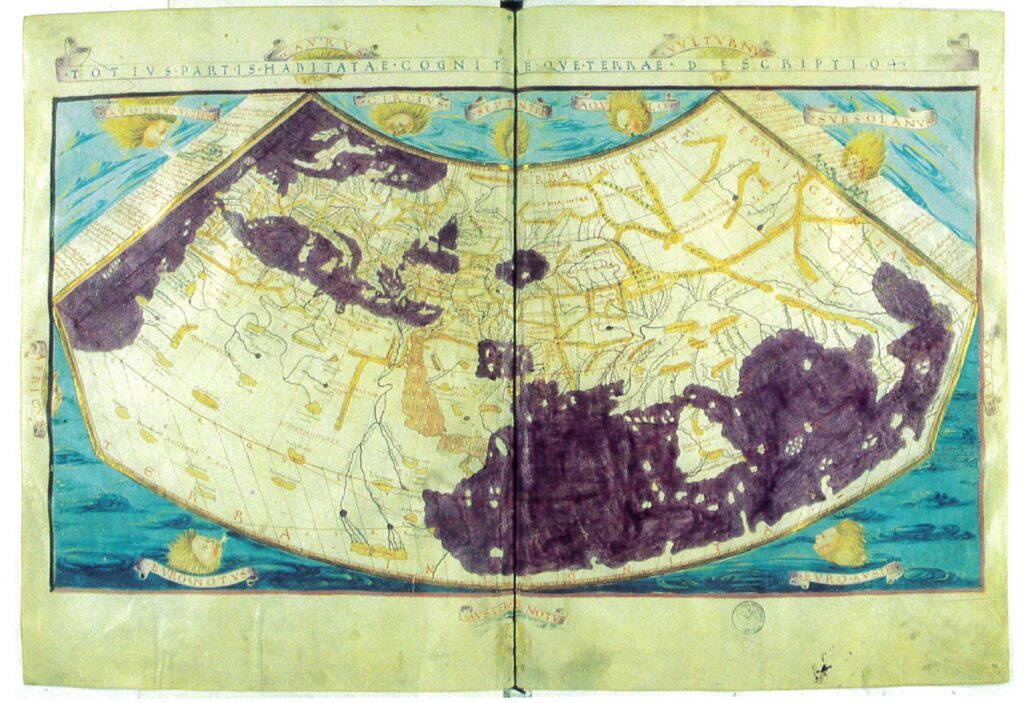Ihsan Abbas

Initially, not fully familiar with al-Rawḍ al-Miʿṭār, I considered it as a geographical gazetteer from which the French orientalist E. Lévi-Provençal had extracted the names of places in Muslim Spain. Lévi-Provençal edited and translated the work into French (published in Cairo, 1937 and in Leiden, 1938). An Italian orientalist, Umberto Rizzitano extracted the names of places in Sicily and published this work in the Journal of the Faculty of Literature at Cairo University (18, 1956, pp.129-181).
The decision of these two orientalists to use al-Rawḍ al-Miʿṭār as a resource made me, wrongly, conclude that this book had to be a work of geography of exceptional importance; indeed, their efforts prompted me to learn more about this book. My general impression was that it was a geographical gazetteer since it was ordered according to the letters of the Arabic alphabet. All I knew about the author was that he was thought to be the noble teacher ʿAbdallāh Muḥammad ibn ʿAbdallāh ibn ʿAbd al-Munʿim al-Ṣanhājī al-Ḥimyarī.
Gradually, I was driven by a desire to uncover the truth about the book and its author. When I was in Istanbul, in 1968, one of my many important priorities was to photocopy a manuscript of al-Rawḍ which had been printed in Ottoman times and that I had found in the Bayram Pasha Library (manuscript no. 44, comprising 409 papers). Without knowing anything about the connection between al-Rawḍ and al-Idrīsī’s Nuzhat al-Mushtāq, I had also made copies of two manuscripts of the latter, which I had also found in Turkish libraries. I then completed my journey and returned to Beirut. Discovering, then, a second copy of al-Rawḍ was a pleasant surprise. By sheer luck, I found this copy, from a manuscript belonging to the Årif Õikmat Library in ʿĀrif Ḥikmat Library in al-Madīnah al-Munawwarah, in the library of my friend, Shaykh Zuhayr al-Shāwīsh.
I then began my search for biographical material on the author, hoping also to figure out the age in which he lived. I read my two copies of the book-taking notes as I did so. The fact that the commentaries written by the two orientalists mentioned above, was very helpful for me.
The difficulty in finding the author’s full biography can be attributed to the fact that his comparatively long list of antecedents (nasab) had been abridged in the sources. I had a handwritten copy of al-Iḥāṭāh fī Tārīkh Gharnāṭah by Lisān al-Dīn ibn al-Khaṭīb copied from al-Kitanīyah Library’s manuscript In it, by good fortune, I found a biography of Muḥammad ibn ʿAbdallāh ibn Abd al-Munʿim, author of al-Rawḍ which makes it clear that he emanated from Sebtah and that he was sent to Granada as part of a delegation from the people of his town to declare their allegiance to the Naṣrid rulers there. As the delegation was leaving the town, two of the companions died. Although Ibn ʿAbd al-Munʿim was among the survivors, he was to die shortly thereafter. These events and others appear in Ikhtiṣār al-Akhbār ʿAmmā kāna bī Thaghr Sebtah min Sinī al-Āthār (Paris, 1932, p. 5.). There are also other sources which provide further information on this matter.1
From the above information, we know that the author was from Sebtah and that he was alive during the eighth century hijrī. Ibn Ḥajar confirms the date of his death (in the eleventh month of 727 hijrī), and that he studied under two Sebtah shaykhs – Abū Isḥāq al-GHāfiqī and Abū al-Qāqim ibn al-Shāṭṭ - and that, like them, he was a grammarian who studied Sībawaih works, a linguist who knew al-Jawāhirī’s Ṣiḥāḥ by heart, a muqriʾ who must have a biography in the dictionaries of the qurrāʾ, an explicator (mufassir) who must have a biography in the dictionaries of the explicator (exegesis) and a scholar of Ḥadīth. Ikhtiṣār al-Akhbār tells us he was buried in Sabta.
What emerges from other sources seemed, however, to contradict to what I had learnt throughout my research.
- According to al-Maqqarī, author of Naftḥ al-Ṭīb, he was not from Sebtah, but an Andalusian from Muslim Spain. Al-Maqqarī, writes: “to return to the author of al-Rawḍ al-Miʿtār, he was as familiar wiith the history of al-Andalus as if he hailed from there, and a house s owner is aware of what it contains”. The author of Nafḥ al-Ṭīb thought that the man who wrote al-Rawḍ was Andalusian, because of his special attention and knowledge of places in Andalusia.
- It is, thus, inferred that he was not from Sabta because not one sentence of what appears on Sabta in al-Rawḍ is actually original. He copied such details from what al-Bakrī and al-Idrīsī wrote about it and from what appeared in al-Tusi’s Kitāb al-Istibṣār. This conclusion is not incontestable because it assumes that Ibn ʿAbd al-Munʿim was an accomplished geographer and he was not. He was not bold enough to make original geographic observations, even about his own country.
- It is more likely, then, that he lived in the ninth rather than the eighth century because he mentions in al-Rawḍ that Sultan Qānṣūh al-Ghūrī (died in 922 hijrī) was the last of the Mamluk sultans to go on. It is possible that this information is a subsequent addition, because it does not appear in one of the two copies and appears in an incomplete form, in the other.
- Hajjī Khalīfah estimates his death at around 900 hijrī in Kashf al-Ẓunūn, but according to his writings about the author (in Flugel’s edition of the book), it seems that he subsequently gives a different year for his death. Elsewhere, however, Hajjī Khalīfah gives one date for Abū Ḥayān al-Tawḥīdī’s death when talking about one book, but gives another date when discussing other books of him. Such discrepancies in Kashf al-Ẓunūn cause doubt about the accuracy of the dates provided for the authors’ deaths.
In this way, all the hypotheses we had previously made, regarding his nasab and his date of death collapse. But what is his connection to al-Rawḍ al-Miʿṭār? There is no mention in any of the biographical sources indicating that he has produced a book of this name. None of the sources makes any claim about his accomplishment as a geographer even though they mention that he was skilled at chess. There is little evidence in the book itself, to assume that he was a geographer, as he did not travel and nor did he record his observations. Yet, the two manuscripts of al-Rawḍ al-Miʿṭār which I have seen, both bare his name, as do the manuscripts which Lévi-Provençal used. Al Qalqashandī (d. 821 hijrī), author of Ṣubḥ al-Aʿshā, took his information from al-Rawḍ al-Miʿṭār, because it was more readily available than original sources.
It seems that Ibn ʿAbd al-Munʿim obtained a copy of al Idrīsī’s Nuzhat al-Mushtāq and, instead of simply copying the material, he extracted from it the names of the known places and arranged them in alphabetical order. He then used al Bakrī’s al-Masālik wa al-Mamālik and other books to obtain the information he needed, which was not available in al-Idrīsī’s work - or was available, but differed from what was in other sources. The proof that he was working from a copied manuscript rather than from listening a shaikh citing a text, is that, when he comes across mis-spelt names he does not know the correct spelling. His ignorance is easy to be spotted, because the names are ordered alphabetically. Examples of this are not hard to find in al-Rawḍ: for example, he places ʿilwah with an ʿayn and ghayn (ghulwah) because he found it with an extra dot. He puts Ḥabrūn under J (jayrūn) because of a confusion of dots. Al-Zabadānī appears as al-Zaidān, etc. Following a long account of Salā which lies near Rabat in Morocco, he discusses Salā in the country of the Takrūr and writes: “I do not know if this Salā is that described as being on the banks of the Nile in Sudan”, (al-Rawḍ, p. 319).
The approach used in the book suggests that his abilities in the field of geography were meager:
- His approach dictates that he mentions a place only if it is already known, whereas a geographer would normally mention both known and unknown places. From this, it is obvious that he was presenting information within a field of science in which his knowledge was quite indaquate.
- The name of a place comprises what is bound to it, whether a story, a judgment, or a piece of news, and this means that he looks for and presents to the reader the result, or his comments on the matter.
The result of this is a lack of profundity in the geographical material. There is confusion when the name of a place is written in two different ways and, linked to this, repetition of information, since he copied what was available in Nuzhat al-Mushtāq, and then found a slightly different account of the same subject in al-Bakrī’s al-Masālik wa al-Mamālik. What was written under one heading might, therefore, appear again under an entirely different one. All of this does not mean that I regret any of the efforts I made to trace the book’s source. Despite all this, al-Rawḍ al-Miʿṭār is very useful and it has proved to be, for me, beneficiary but also difficult.
| Source note: This was published in: The Earth and its Sciences in Islamic Manuscripts: proceedings of the fifth conference of Al-Furqān Islamic Heritage Foundation – English version, 2011, Al-Furqan Islamic Heritage Foundation, London, UK., p 261-268. Please note that some of the images used in this online version of this article might not be part of the published version of this article within the respective book. |


